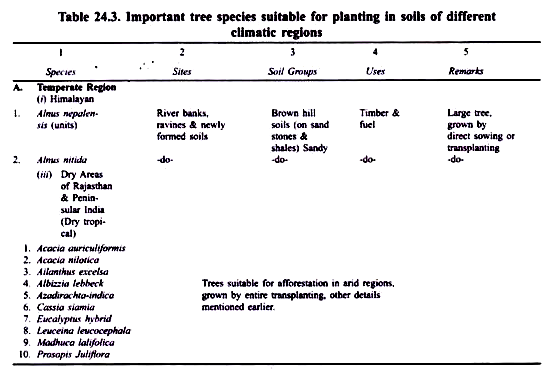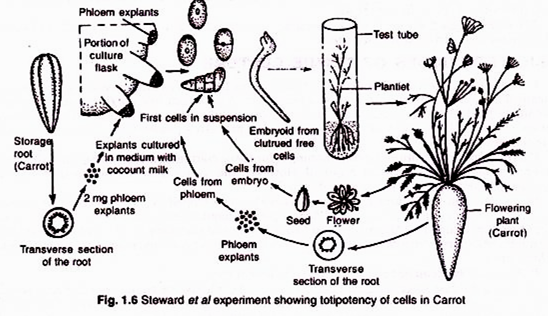In this article we will discuss about:- 1. Occurrence of Laminaria 2. Plant Body of Laminaria 3. Features 4. Reproduction 5. Economic Importance.
Occurrence of Laminaria:
Laminaria (Gr. a thin plate or leaf) with some 40 species are exclusively grown on marine habitat in comparatively shallow water, mainly along the rocky shores, just below the tidal region. They are distributed widely in the Atlantic and Pacific coasts, especially where the water is cool. They are popularly called as “devil’s apron”.
Some common members are L. digitata. L. saccharina, L. japonica, L. flavicans and L. flexicaulis.
Plant Body of Laminaria:
The plant body of Laminaria is diploid and attains a length of 2 to 12 metre or more in length.
The sporophytic plant body is differentiated into holdfast, stipe and blade (lamina) (Fig. 3.123).
Holdfast:
It is an organ of attachment in variable forms. It may be like a solid disc or a cluster of profusely branched cylindrical root-like organs, also called haptera.
Stipe:
It is an unbranched and cylindrical or slightly flattened stalk-like structure, developed on the holdfast and bears terminal blade (s).
Blade (Lamina):
Blade may be simple (L saccharina) or a cluster of vertically divided segments (L. cloustoni, L. digitata) (Fig. 3.123A, B). Blades are flat, long, ribbon-shaped with wavy or smooth margin and tough and leathery in texture. Growth is intercalary and meristematic zone is situated between the stipe and blade.
Most of the members are perennial (L. ephemera etc.) and live about 5 years or more, but in annual member (L. ephemera), a new sporophyte develops in each spring.
Internal Structure of Laminaria:
1. Stipe:
In transverse section, the stipe shows the following regions :
(i) Meristoderm,
(ii) Cortex, and
(iii) Medulla.
i) Meristoderm:
It is the outermost region, consists of one or two layers of small cubical cells containing chromatophores. It remains surrounded by a layer of mucilage and serves the function of assimilation.
ii) Cortex:
It lies just below the meristoderm (between meristoderm and central medulla). The cortex is usually differentiated into outer and inner cortex. The outer cortex is much wider and composed of elongated cells with pointed ends and the inner cortex composed of longer cells with square ends. Mucilage canals or tracts are present in the cortex. The cortical cells serve the function of both storage and mechanical support.
iii) Medulla:
It is the innermost layer, composed of loosely arranged cells and the spaces between them are filled with mucilage. Cross-connections are developed due to fusion of papillose outgrowths of the longitudinal walls. Due to regular cross-connections in the inner layer of cortex and also in the medulla, the layers appear as an entangled net work.
The medulla is characterised by the presence of elongated hyphal structure, the ‘trumpet hyphae’, formed due to swelling at the septa which is larger at one side than the other (Fig. 3.124B). The transverse wall is perforated and shows a close resemblance with the sieve plates of sieve tubes. In older hyphae, the pores are sometimes blocked by callus pads.
2. Blade (Lamina):
Like stipe, the blade also shows the following three main regions in transverse section :
(i) Meristoderm,
(ii) Cortex (outer and inner) and
(iii) Medulla (Fig. 3.124A).
Only the elements of the medulla are drawn out due to greater surface area.
Features of Laminaria:
1. Sporophytic plant body is gigantic in size.
2. Plant body is differentiated into three regions: holdfast, stipe and blade.
3. Internal structure of the plant body is very much complex.
4. Presence of meristematic tissue between stipe and blade causes annual replacement of blade.
5. Sori containing sporangia and paraphyses are developed on blade.
6. Reduction division in zoosporangium causes the development of haploid zoospores (meiozoospores).
7. Gametophytes are heterothallic.
8. Sexual reproduction is oogamous.
9. Fertilisation is external.
10. Alternation of generations is heteromorphic, where predominant sporophyte alternates with the much reduced gametophyte.
Reproduction in Laminaria:
The plant reproduces by all the three means: vegetative, asexual and sexual.
1. Vegetative Reproduction:
The vegetative reproduction takes place by stolons (L. sincelarii, L. longipes etc.). The stolons develop horizontally from the holdfast, grow upwardly into plantlets.
2. Asexual Reproduction:
It takes place by haploid zoospores developed within the club-shaped unilocular sporangia, borne inside the sori (Fig. 3.125A) These haploid zoospores are also called meiozoo- spores or gonozoospores. Sori develop extensively on both the surface of the blade and nearly cover the entire area. Numerous sterile hyphae, the paraphyses are present intermingled with the sporangia.
Development:
Sporangia develop from the superficial cells (meristoderm) of the blade. Initially these cells elongate and divide transversely into upper paraphysis initial and lower basal cell (Fig. 3.125B).
The paraphysis initial elongates and forms an elongated thread with a club-shaped upper region. During this time, the basal cell broadens and thus the paraphyses occupy a limited part towards its basal region. The upper region of the paraphysis contains numerous chromatophores and fucosan vesicles. Each one at its apex develops a cup-like gelatinous thickening (Fig. 3.125C).
By the side of paraphysis, the basal cells enlarge and differentiate into sporangia by transverse wall (Fig. 3.125D). During growth, the sporangia make their way and remain between the paraphyses. The nucleus of the sporangium undergoes first meiotic division, following successive mitotic divisions, thereby 32, sometimes 64 haploid nuclei are developed.
Each nucleus with some cytoplasm and chromatophore gets differentiated into a unit, which later gets differentiated into zoospore. Zoospores are without eye spot (Henry and Cole, 1982), with two lateral flagella (biflagellate) of unequal length (longer one tinsel and shorter one whiplash).
Dehiscence of the sporangia takes place by the lateral pressure of paraphyses on the sporangium. After liberation, the zoospores swim actively for some time. Out of 32 or 64 zoospores, 50% develop into male gametophyte and the remaining 50% into female gametophyte.
After swimming for some time, the meio- zoospores settle down to germinate. After withdrawing flagella, it becomes rounded and secretes a wall. On germination, it develops a small protuberance, which increases in length and its apex becomes bulbous and appears almost like a dumb-bell.
The bulbous region develops into a filamentous gametophyte, consisting of elongated cells. The male and female gametophyte develop male and female sex organ, respectively.
3. Sexual Reproduction:
It is of oogamous type. Sperms and egg produce inside the antheridium (male sex organ) and oogonium (female sex organ), respectively. The male plants become many celled before they develop antheridia (Fig. 3.126A), but the female plants develop oogonia at 2-3 celled stage.
Antheridia develop at the tip of lateral branches of many-celled male plants. Protoplast of each one-celled antheridium metamorphoses into a single pyriform or ellipsoidal antherozoid with two flagella (biflagellate) placed laterally (Fig. 3.126B). Sperms are liberated through the apical region of antheridium. The male plant degenerates after the gametes are released.
Oogonia develop on 2-3 celled female plants (Fig. 3.126C). Oogonia are longer and thicker than the other cells of the female plant. The oogonial protoplast rounds off and becomes differentiated into an egg. At maturity, the egg is not extruded out, but remains attached at the apex of the oogonial wall.
Fertilisation:
After liberating from the antheridium, the antherozoid swims in water. On reaching the oogonium, it unites with egg and forms zygote.
Germination of Zygote:
Soon after the formation of zygote, it develops into a sporophytic plant. Initially, the zygote undergoes successive transverse division and develops into a vertical row of 4-10 cells. Except the lowermost one, all other cells of the filament further divide by both vertical and transverse divisions, thus forming an expanded, thin and flat blade (Fig. 3.127B).
The lowermost cell elongates to form the first rhizoid, but later several rhizoids are developed (Fig. 3.127C). Further division takes place in the lower part of the blade, thus forming meristematic region. With further development, the lower and upper parts of the meristem get differentiated into stipe and blade respectively.
Parthenogenetically, an egg may develop into a plant, as that of sporophytic plant, which is irregular in shape.
Alternation of Generations:
Laminaria exhibits a heteromorphic alternations, showing a prominent and well- developed sporophyte and a very small gametophyte. Asexual reproduction takes place in the sporophytic plant. The zoospores are developed inside the zoosporangium through meiosis and are thus called as zoomeiospores. Half of the zoomeiospores develop multicellular male thalli, where antherozoids are produced inside the antheridium.
The other half develop into female thalli, those develop egg inside oogonium. The entire process of sexual reproduction is unique of its kind. The egg does not retain within oogonium, but it still remains attached with the oogonial wall, indicating a transitional stage between the primitive and advanced nature.
There is spontaneous germination of zygote without rest, while it still remains attached with the female gametophyte. This is found to be an important feature in the life cycle of Laminaria (Fig. 3.128 and 3.129).
Economic Importance of Laminaria:
The economic importance of Laminaria is given:
The burnt ash (Europe) as well as the large brown seaweeds (America) are referred to as “kelp”. The ash contains a large amount of iodine (15 kg/ton).
The industrial use of kelps is for the alginate which has several uses:
(i) In making ice-cream: Manufacturers add algine before freezing their product, which prevents the water from forming coarse ice-crystals in ice-cream, thus it results in a smoother product (Smith, 1955).
(ii) Goiter is treated by giving kelp pills or kelp ash.
(iii) Stipes of Laminaria are used in surgery for opening fistulae (natural opening), because of their swelling properties.
(iv) Brown seaweeds have also been used as green manure for the soil and also as food for animals and human beings.
(v) “Kombu” is a food made from members of Laminariales in Japan.
(vi) In Mainland China, Laminaria is known as “haidai” (sea belt), which has been widely used as a food and medicine for over 1,500 years.






